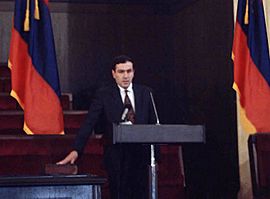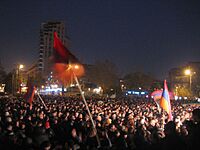Levon Ter-Petrosyan facts for kids
Quick facts for kids
Levon Ter-Petrosyan
|
|
|---|---|
| Լևոն Տեր-Պետրոսյան | |

Ter-Petrosyan in 2014
|
|
| 1st President of Armenia | |
| In office 11 November 1991 – 3 February 1998 |
|
| Prime Minister | Vazgen Manukyan Gagik Harutyunyan Khosrov Harutyunyan Hrant Bagratyan Armen Sarkissian Robert Kocharyan Armen Darbinyan |
| Vice President | Gagik Harutyunyan |
| Preceded by | Position established (Aram G. Sargsyan as First Secretary of the Communist Party) |
| Succeeded by | Robert Kocharyan |
| Chairman of the Supreme Council of Armenia | |
| In office 4 August 1990 – 11 November 1991 |
|
| Preceded by | Hakob Voskanyan (as Chairman of the Supreme Soviet of the Armenian SSR) |
| Succeeded by | Babken Ararktsyan |
| Personal details | |
| Born |
Levon Hakobi Ter-Petrosyan
9 January 1946 Aleppo, Syria |
| Nationality | Armenian |
| Political party | Pan-Armenian National Movement (1989–2008) Armenian National Congress (2008–) |
| Other political affiliations |
Pan-Armenian National Movement (2008–2013) |
| Spouse | Lyudmila Ter-Petrosyan (née Pleskovskaya) |
| Children | David Ter-Petrosyan |
| Alma mater | Yerevan State University Leningrad State University |
| Signature | |
Levon Ter-Petrosyan (born January 9, 1946) is an Armenian politician and historian. He was the first president of Armenia from 1991 until he stepped down in 1998. People sometimes call him LTP.
Before becoming president, he was a senior researcher at the Matenadaran, a famous library of ancient manuscripts. He became a leader of the Karabakh movement in 1988. This movement aimed to unite the Armenian-populated region of Nagorno-Karabakh with Armenia. After Armenia became independent from the Soviet Union in September 1991, Ter-Petrosyan was elected president. He led the country during the First Nagorno-Karabakh War against Azerbaijan.
He was reelected in 1996, but there were claims of election fraud. This led to large protests, which were stopped by military force. He resigned in 1998 because he disagreed with his government members about a peace plan for the Nagorno-Karabakh conflict.
After his resignation, Ter-Petrosyan stayed out of politics for a while. He returned in 2007 and ran for president again in 2008. He lost the election and claimed it was rigged. This led to big protests where ten people died. In 2008, he started the Armenian National Congress (ANC), a group of opposition parties. The ANC organized more protests in 2011. In the 2012 elections, the ANC won 7 seats in parliament. However, they have not been in parliament since.
Contents
Early Life and Education
Levon Ter-Petrosyan was born on January 9, 1946, in Aleppo, Syria. His family was Armenian and came from a place called Musa Dagh. His family had been involved in fighting during the Armenian genocide before moving to Syria. His father, Hakob Ter-Petrosyan, was a member of the Hunchakian Party and later helped start the Syrian Communist Party.
He had three brothers and one sister. His family moved to Soviet Armenia in 1947 when he was very young.
In 1969, he finished his studies at Yerevan State University. He continued his education at Leningrad State University (now Saint Petersburg State University) and earned his doctoral degree there in 1987. He worked as a researcher at the Armenian Academy of Sciences and later at the Matenadaran.
Academic Achievements
Ter-Petrosyan wrote his doctoral paper on the Assyrian language and how it relates to Armenian. He has written over 30 books and about 80 scientific articles in Armenian, French, and Russian. He has also published many political articles and speeches. He is a member of the Writers Union of Armenia and has received honorary degrees from several universities around the world.
Leading the Karabakh Movement
In the late 1980s, a movement began in Soviet Armenia and Nagorno-Karabakh to unite the region with Armenia. In May 1988, Levon Ter-Petrosyan and others formed a new Karabakh Committee. This committee soon became the main leader of the movement. Under his leadership, the Karabakh movement also pushed for more democracy.
From December 1988 to May 1989, Ter-Petrosyan was held in a prison in Moscow with other committee members. After they were released, they returned to Yerevan and continued their work. In 1989, Ter-Petrosyan and the committee members started a political party called the Pan-Armenian National Movement. He later became the party's leader.
In 1990, Ter-Petrosyan was elected to the Supreme Soviet of Armenia. His party won most of the seats, becoming the first non-communist party to take power in a Soviet republic. On August 4, 1990, he was elected Chairman of the Supreme Council of Armenia, making him the country's leader.
As Armenia moved towards independence, there were more clashes with Soviet forces and on the border with Azerbaijan. Ter-Petrosyan opposed a coup attempt against Soviet leader Mikhail Gorbachev in August 1991. On September 20, 1991, Armenians voted for independence, and the country officially declared it three days later.
Presidency: 1991–1998
First Term as President
Levon Ter-Petrosyan became the first President of independent Armenia on October 16, 1991, winning 83% of the votes. He brought Armenia into the Commonwealth of Independent States (CIS) after the Soviet Union ended. In December 1991, he appointed Vazgen Sargsyan as the first Defense Minister. In January 1992, the Armed Forces of Armenia were officially created.
The fighting in Nagorno-Karabakh grew into a full-scale war. In May 1992, Armenian forces achieved a major victory by capturing Shusha. Weeks later, they captured Lachin, which connects Armenia with Nagorno-Karabakh. The war ended with a ceasefire agreement in May 1994. Armenia, Azerbaijan, and Nagorno-Karabakh signed the Bishkek Protocol.
Despite efforts to improve relations with Turkey, the capture of the Kalbajar district by Armenian forces in April 1993 worsened relations. Turkey closed its border with Armenia, and it remains closed today.
Armenia faced severe economic problems after the Soviet Union broke up. The country was landlocked and had few natural resources. Azerbaijan imposed a trade embargo, cutting off energy supplies. The border with Turkey was closed, and routes through Georgia were often disrupted by civil unrest. Armenia's economy suffered greatly, and many people left the country. However, economic reforms were put in place, which helped the country start building a market economy.
During his first term, there were also tensions between his government and the Armenian Revolutionary Federation (ARF), a nationalist political party. In 1994, Ter-Petrosyan accused the ARF of trying to overthrow the government. The party was banned in Armenia, and many of its members were arrested. The ban was lifted by his successor, Robert Kocharyan, after Ter-Petrosyan resigned.
1996 Reelection and Protests
Ter-Petrosyan was reelected in the 1996 Armenian presidential election. Official results showed he won with about 52% of the vote. However, the opposition and many international observers claimed there was election fraud. On September 25, 1996, about 200,000 people protested in Yerevan. Some stormed the parliament building. Tanks and troops were brought in to stop the protests. Later, a former minister admitted that the government had rigged the election.
Why He Resigned
Ter-Petrosyan had to resign in February 1998. This happened because he supported a peace plan for the Nagorno-Karabakh conflict. Many Armenians felt this plan would make their country less safe. Key ministers in his government, including Prime Minister Robert Kocharyan and Defense Minister Vazgen Sargsyan, disagreed with the plan. The plan suggested returning most of the Armenian-controlled territories around Nagorno-Karabakh. In return, international peacekeepers would be deployed, and blockades by Azerbaijan and Turkey would be lifted. The final status of Nagorno-Karabakh would be decided later. Ter-Petrosyan said he resigned to prevent further instability in the country.
Return to Politics
After resigning, Ter-Petrosyan mostly stayed out of public life and focused on scientific research. He published a two-volume historical work called The Crusaders and the Armenians.
2008 Presidential Election
On September 21, 2007, Ter-Petrosyan gave his first public speech in almost ten years. He strongly criticized President Kocharyan's government for corruption. He then announced he would run for president in the 2008 Armenian presidential election. He argued that the government's claims of economic growth were false. He also said that the government had accepted a solution for Nagorno-Karabakh that was similar to what he had proposed years earlier. Several opposition parties supported him.
Protests After the Election
The election was held on February 19, 2008. Official results showed Ter-Petrosyan in second place. He and his supporters claimed the election was rigged and that he had won. Starting on February 20, he led large protests in Yerevan.
On March 1, authorities moved in to clear the protest camp. Law enforcement agents used force to disperse hundreds of protesters. Ter-Petrosyan was placed under house arrest. Later that day, tens of thousands of protesters gathered again. Police were overwhelmed, and a state of emergency was declared. Clashes resulted in the deaths of eight protesters and two policemen. Ter-Petrosyan told his supporters to go home to avoid more casualties.
Armenian National Congress
In 2011, Ter-Petrosyan again led protests in Armenia. As the leader of the Armenian National Congress (ANC), he called for the release of political prisoners and a full investigation into the violence of March 2008.
2012 Parliamentary Election
Levon Ter-Petrosyan led the ANC in the 2012 Armenian parliamentary election. The ANC won 7.08% of the popular vote, which gave them 7 seats in parliament.
2013 Presidential Election
In December 2012, Ter-Petrosyan announced he would not run for president in the February 2013 election. He said that a 68-year-old person should not seek the presidency in a democratic country. The ANC decided not to participate in the election, calling it a way to "legitimize the illegal regime."
In April 2013, the Armenian National Congress changed from an alliance of parties into a single political party.
2021 Parliamentary Election
Ter-Petrosyan led the ANC's list in the 2021 Armenian parliamentary election. He stated he would not take his parliamentary seat if the ANC did not win a majority. The ANC received 1.54% of the vote, which was below the 5% needed to enter parliament.
2020 Nagorno-Karabakh War and Aftermath
During the 2020 Nagorno-Karabakh war, Ter-Petrosyan met with other former presidents of Armenia and Nagorno-Karabakh to discuss the situation. He and Robert Kocharyan asked to go to Moscow as special negotiators, but the visit did not happen.
After Armenia's defeat in the war and the signing of a ceasefire agreement, protests began against Prime Minister Nikol Pashinyan. Ter-Petrosyan warned against a civil war and called for a peaceful solution to the political crisis. He urged the prime minister to resign and accused both the prime minister and the opposition of causing conflict.
In March 2021, Ter-Petrosyan met again with former presidents Kocharyan and Sargsyan. He proposed that they form an alliance to remove Prime Minister Pashinyan in the 2021 election, but both Kocharyan and Sargsyan rejected this idea.
Personal Life
Levon Ter-Petrosyan is married to Lyudmila Ter-Petrosyan. They have one son, David, who is an economist and businessman. They also have four grandchildren.
Ter-Petrosyan speaks Armenian and Russian fluently, and he knows parts of nine other languages.
Images for kids
See also
 In Spanish: Levon Ter-Petrosián para niños
In Spanish: Levon Ter-Petrosián para niños





